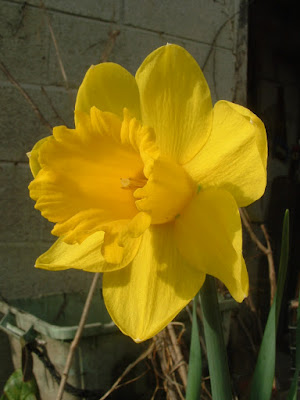I still don't have a photo of my allotment! Picture an open, flat but very slightly sloping plot, the center third of which is covered in large sheets of cardboard, weighted down by bricks and odd bits of pallet wood. There's a roof-less A-frame chicken house approximately 1 m tall in one grassy corner at the bottom, a very weedy patch of moth-eaten looking cabbages in the next corner, an uncovered compost pile near some odds and ends such as a short roll of chicken wire and a few panes of glass (from a non-existent greenhouse) at the top, and a few newly cultivated patches just below it.
These cultivated patches were the section I first covered in cardboard last year, and are the only place where it has managed to break down fully (it was also covered in weed and plant trimmings, which no doubt helped keep them moist and compost down quicker). Despite this, the weeds and grass underneath were not quite all dead yet, so digging and raking was done, by me, the husband and the son. We sowed a triple row of broad beans, two triple rows of regular peas, and a single row of yellow mange tout peas (both peas I saved myself from last year's harvest, but there wasn't much mange tout) and put in pea sticks for them to grow up (the broad beans are only dwarf and won't need supports). I also put down a few short rows of early veg seeds like spring onion, miners lettuce, carrots, beetroot, mizuna, and arugula.
Then last weekend, the husband took two smaller pallets we'd scavenged and turned them into basic cold frames and we built and sowed a hot bed under one of them: we dug a hole the width and length of the frame, about 30 cm deep, packed it with two wheelbarrows of horse manure and straw, then loaded the soil back on top. The frame fits over it with two of the above-mentioned panes of glass resting on top. The idea is the manure heats up the soil as it composts, and the glass keeps the heat in, encouraging plants to grow quickly, particularly this time of year when the soil is still fairly cold. I sowed turnips, beets and lettuce in it.
Despite the digging and raking, I think we'll be fighting the grass all this year. Hopefully we can get it under control, and with one more winter of sheet mulch, eradicate it.






